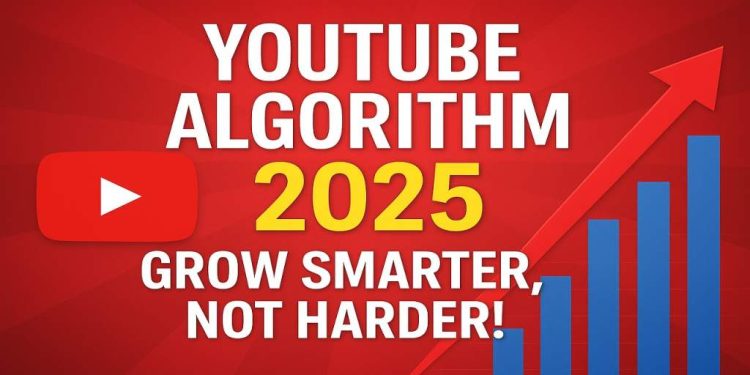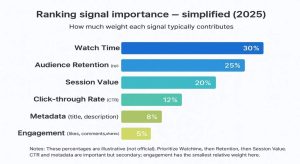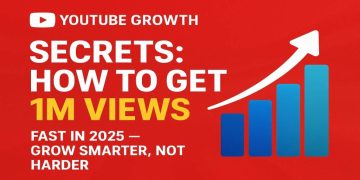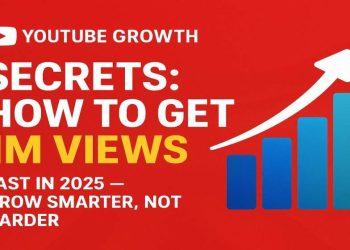The YouTube Algorithm in 2025 focuses more on viewer satisfaction than ever before. Success no longer depends just on clicks but on how long users watch, how engaged they stay, and whether your videos drive them to watch more. Key ranking signals include Watch Time, Audience Retention, and Session Value, with CTR and metadata playing supportive roles.
Creators must focus on making highly engaging, binge-worthy content that keeps viewers hooked. Optimize titles, thumbnails, and storytelling to maximize retention and encourage longer sessions. Growing smarter means building trust with your audience and working with the algorithm, not against it.
What Changed in 2025
Key takeaway: The algorithm promotes videos that keep viewers on the platform and satisfy intent — measured not just by clicks, but by watch time, retention, session impact, and viewer feedback. Put differently: clicks without satisfaction are temporary; retention + session value win in the long run.
How the YouTube algorithm works Now (Core Principles)
The YouTube recommendation system is a set of models that predict which videos will best satisfy individual users right now. It combines signals about the viewer (history, preferences, session context), signals about the video (metadata, content quality, historical performance), and a feedback loop (engagement, watch behavior, and explicit feedback like “Not interested”). The platform makes decisions at two levels:
- Candidate generation — find a pool of potentially relevant videos for a user.
- Ranking — estimate which candidate will produce the best outcome for that user (watch time, satisfaction, session continuation) and order them.
These models are increasingly powered by machine learning — including generative AI for better topic understanding and for generating UI features such as AI-powered search carousels. YouTube announced AI-powered search carousels and other discovery tools in 2025.
What “success” means to YouTube in 2025
- Viewer satisfaction: Does the viewer feel the video met their intent?
- Session value: Does the video lead the viewer to stay longer on YouTube overall?
- Long-term value: Do viewers return to the channel and discover more related content?
Primary ranking signals — and how to optimize each
Below are the most practical, high-impact signals creators can influence. After each factor you’ll find what to measure, how to test, and action steps.
1) Watch time & total minutes viewed
Why it matters: YouTube promotes content that accumulates watch time because watch time keeps users on the platform longer — the single most defensible metric for engagement. Multiple creator guides (and YouTube-adjacent SEO research) list watch time and total minutes as core ranking signals in 2025.
How to measure: Use YouTube Studio: total watch time, average view duration, and minutes-per-video in the Analytics tab.
Optimization checklist: tight opening hook, structure to minimize mid-roll drop-offs, chapters to help retention, and removing or reworking weak intros. Test retention by A/B thumbnail/title and compare cohort watch time.
2) Audience retention (relative retention)
Why: Absolute watch time is important, but YouTube cares about relative retention (how well your video retains viewers compared to other videos of similar length/genre). High relative retention signals that your content is satisfying for that topic. :contentReference[oaicite:4]{index=4}
Action: Plot the retention curve in YouTube Analytics and identify drop-off points. Tighten sections that cause dips, shorten or restructure mid-segments, and experiment with faster pacing, B-roll, and on-screen text to re-capture attention.
3) Click-through rate (CTR) from impressions
Why: CTR (how often people click your thumbnail after seeing it) tells the algorithm if your creative is relevant and compelling. But CTR alone is insufficient — if CTR is high and retention is low, the algorithm will slow promotion. Balance curiosity with accurate promise.
Action: Use compelling thumbnails + honest titles. Run experiments: change thumbnail color/subject, test text overlays, or test face vs no-face. Monitor CTR + 1-minute retention together.
4) Session Duration & Session End Rate
Why: YouTube measures whether a video ends the viewer’s session or leads them to keep watching. Videos that lead to further viewing are preferred. This means your content should ideally act as a gateway — either by recommending another video, using end-screens, or creating natural curiosity to continue.
Action: End with hooks to another video, playlists, or a clear next-step. Monitor “Viewers who watched this also watched” via analytics and add relevant links.
5) Engagement signals: likes, comments, shares
Why: Engagement is still a useful signal for topical interest and satisfaction. However, explicit engagement has less weight than retention metrics; YouTube prefers behavioral signals over manipulable social metrics. Genuine comments that show watch-through (like timestamps, quotes) are especially valuable.
Action: Use clear CTAs that invite thoughtful comments (a specific question), pin meaningful comments, and engage with replies to increase conversation quality.
6) Viewer feedback (Not interested, dislikes, etc.)
Why: Negative feedback directly tells the recommendation system that a video was a poor fit for some viewers, and it reduces distribution. High rates of “Not interested” or “I don’t like this” can quickly throttle a video’s reach.
Action: Avoid misleading thumbnails/titles and be careful with polarizing or clickbait tactics that create quick bounces and negative feedback.
7) Relevance signals: metadata & topic understanding
Why: The system uses titles, descriptions, tags, transcript/CC, and in-Video analysis (AI) to understand topical relevance. In 2025 YouTube invested in AI to extract topic-level understanding to better match videos to queries and suggested carousels.
Action: Use accurate titles, descriptive descriptions with target keywords in natural language, full transcripts, and structured timestamps. Add clear chapter titles — they help both viewers and the algorithm identify video sections.
Shorts vs Long-form: strategy differences
YouTube operates multiple recommendation funnels: Shorts has a different distribution model optimized for rapid consumption and discovery via swiping; long-form lives in search, recommendations, and browse. Both can feed each other (using Shorts as an attention gateway to long-form).
Changes to counting and metrics for Shorts in 2025 altered how creators evaluate reach: YouTube changed some view-count and analytics behaviors to better reflect plays, while still using engaged watch metrics for monetization and deeper ranking signals.
Shorts strategy (high-velocity experimentation)
- Prioritize immediate hook (0–3s).
- High frequency — test 3–7 per week to find formats that scale.
- Use Shorts to funnel viewers to playlists or long form.
- Measure both raw plays and engaged views (analytics labeled terms vary; use “Average view duration” for Shorts when available).
Long-form strategy (authority & watch time)
- Aim for 8–15 minutes when the topic benefits from depth — many 2025 analyses report sweet spots around ~8–12 minutes for sustained watch time in search-friendly content.
- Structure with chapters, mid-roll value, and actionable takeaways.
- Use playlists to increase session watch time and signal topical authority.
Step-by-step SEO & upload checklist
Use this checklist before you publish. Each step is actionable and measurable.
- Keyword & intent research: pick a primary keyword + 2–3 secondary queries.
- Title (60–80 chars): Primary keyword first, promise + benefit, avoid clickbait.
- Thumbnail: High contrast, readable text, clear subject, emotional cue — test two variants first 24–48 hours.
- Description: First 1–2 lines should be keyword-rich and compelling (these appear in search). Add 3–5 resource links, timestamp chapters, and CTA.
- Transcript & captions: Upload SRT or auto-generate and edit. Transcripts help AI understand your content.
- Tags: Use a few targeted tags and a couple of broad category tags; not a primary ranking signal but useful for early discovery.
- Chapters: Add at least 3-5 chapter markers to increase usability and help retention.
- End screens & cards: Link to next-step videos and playlists.
- Playlists: Ensure video is in at least 1 relevant playlist on upload.
- Promotion plan: Share on socials, community tab, and cross-promote via Shorts where relevant.
- Analytics check: 24–48 hour window: compare Impressions → CTR → 30s retention → 3–7 day watch time growth.
Case studies & experiments you can run
Here are experimental designs you can run on your channel (small-N tests you can scale if positive):
Experiment A — Thumbnail A/B
- Upload same video twice, spaced by two weeks, with different thumbnails (or use YouTube experiments if available).
- Measure first 72-hour CTR and 7-day average view duration.
- Decision rule: if new thumbnail raises CTR by +10% and doesn’t lower 7-day retention by >5% → adopt.
Experiment B — Short teaser funnel
- Create a 30–45s Short summarizing the long-form video and include a clear CTA to watch full video in comments and pinned description link.
- Measure referral traffic to the long-form video and new-subscriber conversion.
Experiment C — Chapter optimization
- Publish two versions of a tutorial: one with detailed chapters and timestamps, one without.
- Track session duration, watch time, and “watch next” behavior across 14 days.
Ranking graph: Visualizing signal importance
Below is a simplified visualization of how much weight different signals typically contribute to discoverability in 2025 (relative — not official). Use it to prioritize optimization work.
Notes: These relative weights are illustrative and based on observed changes to recommendation priorities in 2025: watch/retention/session signals dominate, with CTR and metadata still useful but secondary.
Common myths debunked
Myth: “High views instantly equals long-term growth.”
Reality: Views without retention or session continuation are short-lived. The algorithm tests videos quickly — if viewers don’t stay YouTube reduces distribution. Focus on quality and retention, not vanity view totals.
Myth: “Tags are the main ranking factor.”
Reality: Tags can help with early discovery but are far less important than retention, watch time, and metadata/readable transcripts. Use tags sensibly, but don’t rely on them.
Myth: “You must always publish at a fixed schedule.”
Reality: Consistency helps, but quality and activation are more important. If you can reliably produce high-retention content on a weekly schedule, that’s better than poor content daily. Use your analytics to find the cadence that yields best long-term watch time growth.
Final Roadmap to consistent growth (90-day plan)
Follow a three-month plan to build momentum that aligns with how the algorithm rewards behavior.
Days 1–14: Diagnosis & quick wins
- Audit last 10 videos: retention curves, CTR vs impressions, session lift.
- Fix thumbnails for top 3 worst-performing impressions videos; reupload or use experiments.
- Publish 3 Shorts that directly point to two pillar long-form videos.
Days 15–45: Systems & hypothesis testing
- Run the Thumbnail A/B experiment and one Chapters experiment.
- Create two evergreen long-form videos (8–12 min) optimized for search with rich descriptions and transcripts.
- Standardize upload template: title + 1st-line description + chapters + transcript.
Days 46–90: Scale what works
- Double down on the formats that produced higher retention & session lift.
- Build playlists and cross-link videos to maximize session watch time.
- Replicate successful Short formats and use them as traffic drivers for long-form content.
Related – Top Google Tools to Dominate SEO in 2025





















